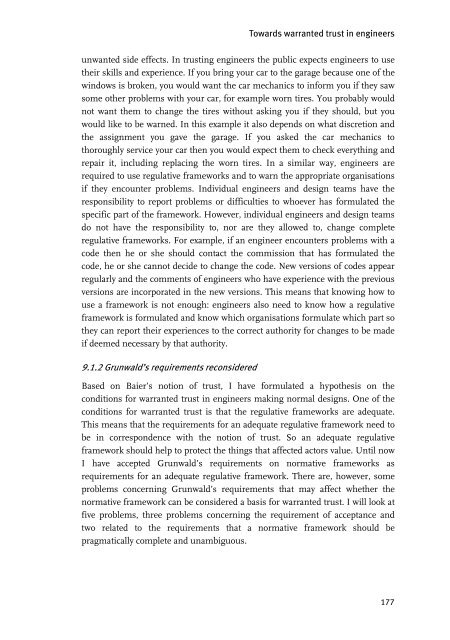Ethical issues in engineering design - 3TU.Centre for Ethics and ...
Ethical issues in engineering design - 3TU.Centre for Ethics and ...
Ethical issues in engineering design - 3TU.Centre for Ethics and ...
You also want an ePaper? Increase the reach of your titles
YUMPU automatically turns print PDFs into web optimized ePapers that Google loves.
Towards warranted trust <strong>in</strong> eng<strong>in</strong>eers<br />
unwanted side effects. In trust<strong>in</strong>g eng<strong>in</strong>eers the public expects eng<strong>in</strong>eers to use<br />
their skills <strong>and</strong> experience. If you br<strong>in</strong>g your car to the garage because one of the<br />
w<strong>in</strong>dows is broken, you would want the car mechanics to <strong>in</strong><strong>for</strong>m you if they saw<br />
some other problems with your car, <strong>for</strong> example worn tires. You probably would<br />
not want them to change the tires without ask<strong>in</strong>g you if they should, but you<br />
would like to be warned. In this example it also depends on what discretion <strong>and</strong><br />
the assignment you gave the garage. If you asked the car mechanics to<br />
thoroughly service your car then you would expect them to check everyth<strong>in</strong>g <strong>and</strong><br />
repair it, <strong>in</strong>clud<strong>in</strong>g replac<strong>in</strong>g the worn tires. In a similar way, eng<strong>in</strong>eers are<br />
required to use regulative frameworks <strong>and</strong> to warn the appropriate organisations<br />
if they encounter problems. Individual eng<strong>in</strong>eers <strong>and</strong> <strong>design</strong> teams have the<br />
responsibility to report problems or difficulties to whoever has <strong>for</strong>mulated the<br />
specific part of the framework. However, <strong>in</strong>dividual eng<strong>in</strong>eers <strong>and</strong> <strong>design</strong> teams<br />
do not have the responsibility to, nor are they allowed to, change complete<br />
regulative frameworks. For example, if an eng<strong>in</strong>eer encounters problems with a<br />
code then he or she should contact the commission that has <strong>for</strong>mulated the<br />
code, he or she cannot decide to change the code. New versions of codes appear<br />
regularly <strong>and</strong> the comments of eng<strong>in</strong>eers who have experience with the previous<br />
versions are <strong>in</strong>corporated <strong>in</strong> the new versions. This means that know<strong>in</strong>g how to<br />
use a framework is not enough: eng<strong>in</strong>eers also need to know how a regulative<br />
framework is <strong>for</strong>mulated <strong>and</strong> know which organisations <strong>for</strong>mulate which part so<br />
they can report their experiences to the correct authority <strong>for</strong> changes to be made<br />
if deemed necessary by that authority.<br />
9.1.2 Grunwald’s requirements reconsidered<br />
Based on Baier’s notion of trust, I have <strong>for</strong>mulated a hypothesis on the<br />
conditions <strong>for</strong> warranted trust <strong>in</strong> eng<strong>in</strong>eers mak<strong>in</strong>g normal <strong>design</strong>s. One of the<br />
conditions <strong>for</strong> warranted trust is that the regulative frameworks are adequate.<br />
This means that the requirements <strong>for</strong> an adequate regulative framework need to<br />
be <strong>in</strong> correspondence with the notion of trust. So an adequate regulative<br />
framework should help to protect the th<strong>in</strong>gs that affected actors value. Until now<br />
I have accepted Grunwald’s requirements on normative frameworks as<br />
requirements <strong>for</strong> an adequate regulative framework. There are, however, some<br />
problems concern<strong>in</strong>g Grunwald’s requirements that may affect whether the<br />
normative framework can be considered a basis <strong>for</strong> warranted trust. I will look at<br />
five problems, three problems concern<strong>in</strong>g the requirement of acceptance <strong>and</strong><br />
two related to the requirements that a normative framework should be<br />
pragmatically complete <strong>and</strong> unambiguous.<br />
177



